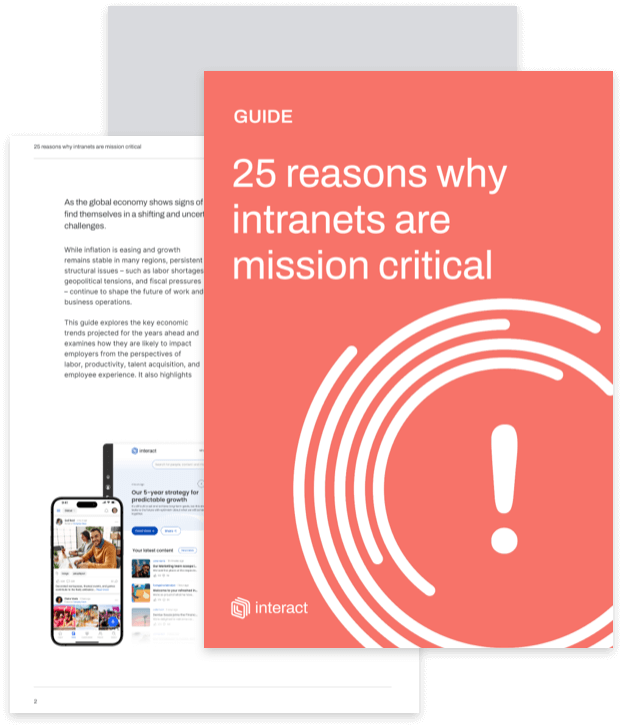Intranet software delivers more than just better internal comms. When deployed successfully, an intranet platform improves collaboration, productivity, and knowledge sharing across your organization. Check these 10 essential intranet uses cases to discover best uses for an intranet in your enterprise.
Due to technological advances and shifting work patterns, the modern workplace is changing rapidly. Organizations want to help employees thrive in an evolving world, so they implement technologies that support collaboration and communication. When it’s planned and deployed successfully, intranet software can be a critical part of a digital workplace ecosystem that makes all staff feel connected and empowered.
How effective are internal communication tools ? One study by the McKinsey Global Institute found that productivity levels rose by as much as 20-25% among workers who use online social tools to collaborate.
How can you use an intranet?
Intranet software isn’t solely for comms, however, and there are many examples of organizations developing creative and effective intranet use cases beyond the norm.
1 – Automate mundane tasks
Every organization has low-level tasks that take up employee time but unfortunately cannot be avoided. They range from reserving rooms and equipment to booking absences and filling out HR forms. One thing a company intranet can be used for is automating this kind of routine work.
What does this look like in action?
Imperial College Healthcare NHS Trust has over 12,000 employees operating across five hospitals and in various communities. Operating in a highly pressurized and regulated sector, and with staff performing a vast array of different roles, balancing efficiency with safe clinical care is a constant focus. Those mundane tasks are time-consuming but often critical.
The Trust intranet has proven invaluable as a support tool for workers, in a number of ways.
Is your intranet mission critical?
For example, a purpose-designed intranet onboarding area for junior doctors joining the Trust gives early-doors access to vital materials and information, speeding up the onboarding process and automating much of the paperwork.
Digital forms have replaced paper-based versions for vital tasks including uniform ordering, interpreter booking, and patient transport booking, freeing up valuable time.
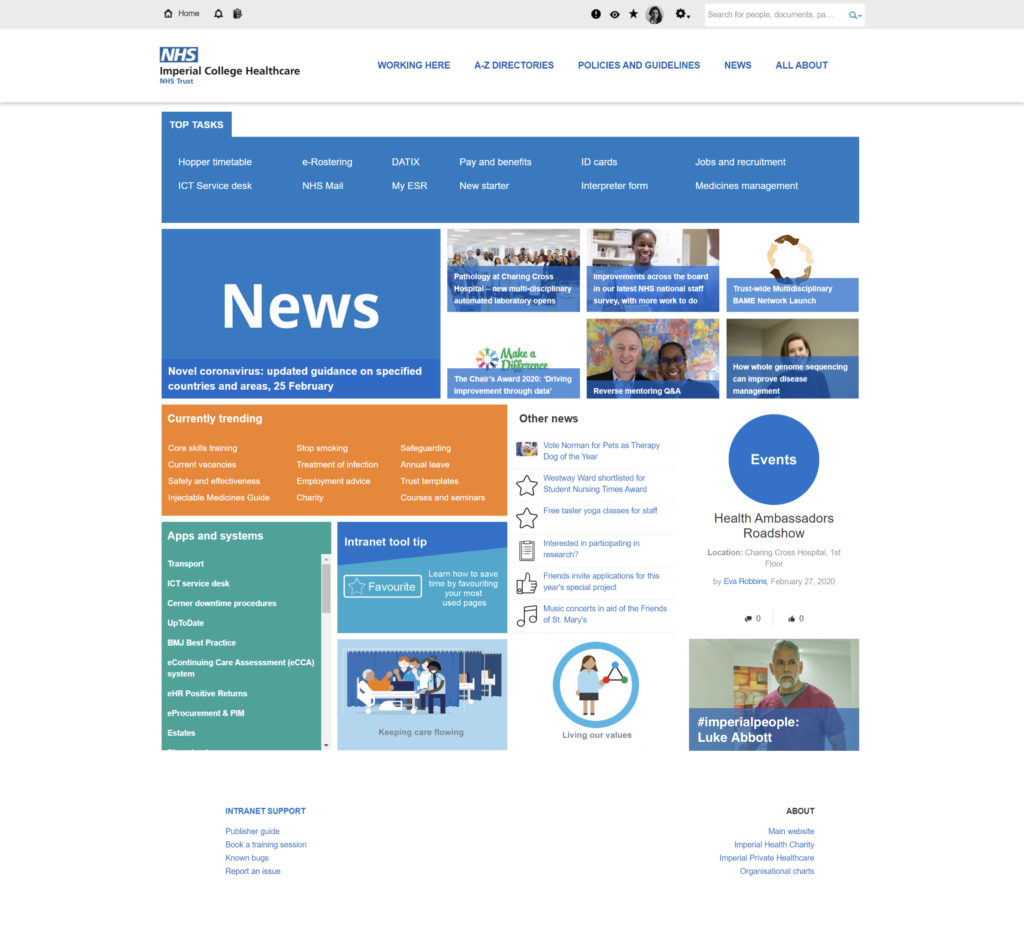
The intranet software is also designed around the needs of its users: ensuring what they need and use most is right at their fingertips through the ‘Top Tasks’ toolbar and quicklinks. Single sign-on streamlines logging in to vital apps such as the ICT helpdesk and inpatient record system, aiding productivity.
By making their processes more efficient and paying attention to the needs of their employees, Imperial College Healthcare NHS Trust is a perfect example of how intranet uses cases can vary from usual expectations.
2 – Create a knowledge base for information sharing
There is no question that sharing knowledge has demonstrable ROI for businesses.
According to one study, Fortune 500 companies lose around $31.5 billion per year by failing to share knowledge. Like other aspects of collaboration, though, knowledge sharing has to be purposeful to be effective.
One of the strongest intranet use cases we see includes building knowledge bases that keep staff, partners, and even customers informed. These are especially effective when accessible through an employee communication app.
Fortune 500 companies lose around $31.5 billion per year by failing to share knowledge.
AMC Networks, the global company behind brands including AMC and BBC America, set out to achieve this on their intranet, The Source. The clue is in the name: it is now the source of all internal knowledge and information, providing a global hub to connect employees worldwide.
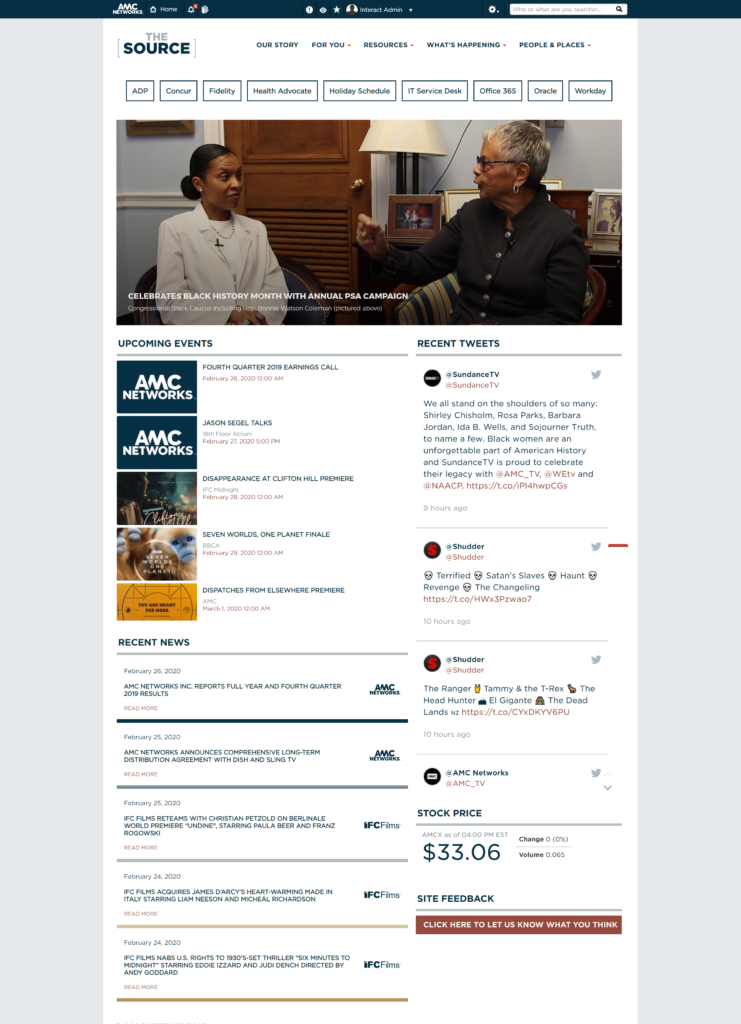
Combining a user-led design and strategic approach to populating their content areas means staff now have easy access to the people and things they need to get work done.
The site sees an average of 800 visits daily and 75% active users, with communities now created for everything spanning Diversity and Inclusion to ‘Inside Look’, an executive blog series to give staff visibility of what’s happening at AMC Networks.
3 – Use a multi-language intranet to connect diverse workforces
A frequent problem, especially in large organizations, is transparency and connection.
As organizations grow, it becomes more difficult for the average worker to be in contact with senior management and executives. This means expectations and guidelines become unclear, purpose and direction aren’t fully understood, and success becomes less well understood.
For management, a lack of personal connection may prevent them from understanding the realities of how the organization works on the ground and adjusting strategy accordingly.
Humanitarian organization, International Rescue Committee, operates in over 40 countries with over 13,000 staff contributing to its mission. Giving staff visibility of what key figures and peers are doing, enabling them to hear directly from their leaders, and sharing the ‘bigger picture’ are all critical to fostering a connection to the cause.
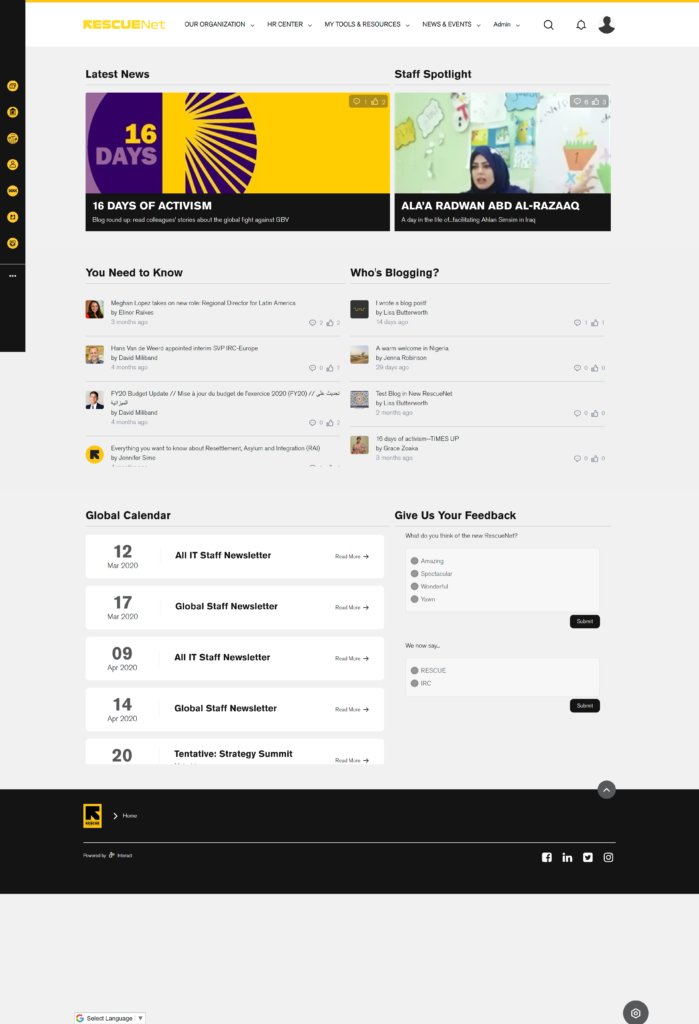
IRC uses its intranet, RescueNet, as a central and accessible platform for every employee. Tapping into the power of video, senior leaders and employees alike regularly share short videos with updates, news, and messages. CEO David Miliband shares organization updates, field and travel stories, and shout-outs to staff in vlog form, with translation into its three core languages to engage more workers.
Staff can also comment, share, and like; engaging as active participants in their organization. The organization has managed to bridge the gap between employees and those on a higher level in order to clarify and streamline. This truly helps employees understand the impact of their work and the mission of the organization, along with how they fit into overall company goals.
4 – Create a digital hub for everyone
Hybrid and remote work are increasingly popular, and it’s now normal for businesses to allow employees significant flexibility in working from home.
Alongside this, large enterprises often have staff operating in stores, supply chain, or in production. This mix of roles and locations presents both an opportunity and a challenge for purposeful collaboration in the form of keeping workers in different locations connected to one another.
One of the most significant intranet use cases is that it can be used as the center of a digital workplace the meets the needs of many disparate groups.
For global foreign exchange experts, Travelex, those borders present a challenge. Staff are dispersed across different timezones, working on the frontlines in booths or stores, and speak multiple languages. This has the potential to cause some individuals to feel cut off from the organization, and each other. Its intranet, The Lounge, now serves to connect all individuals around the globe.
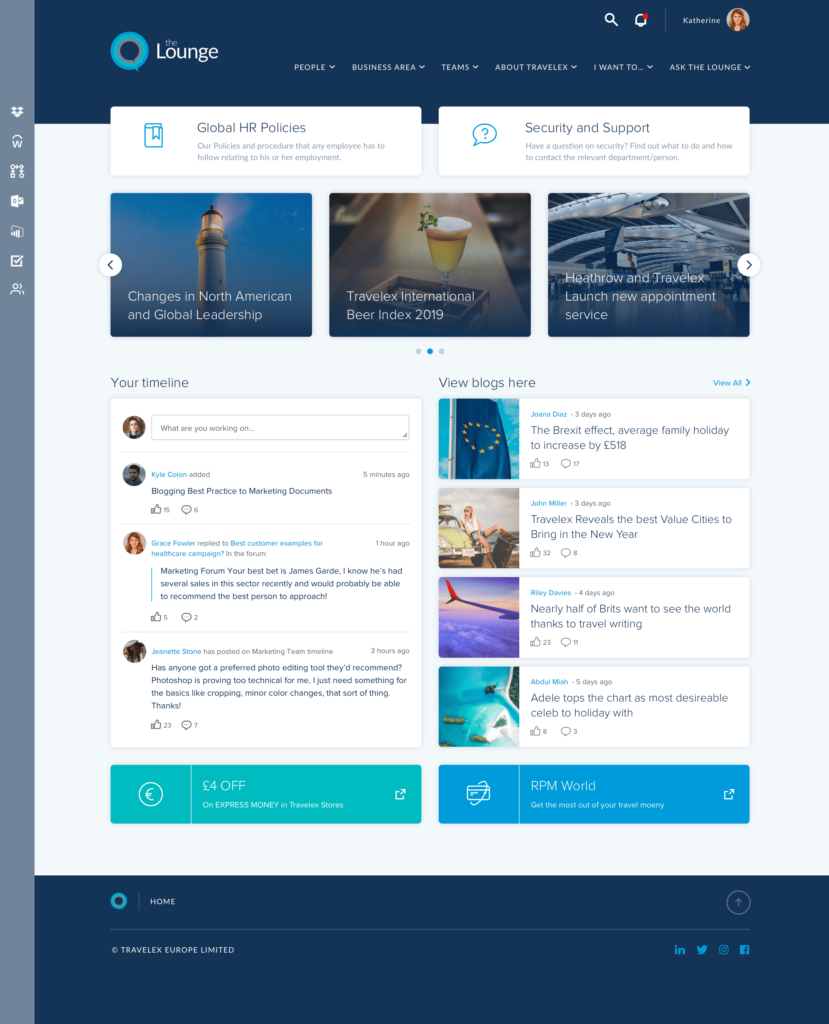
By combining business-critical functions, such as hosting important information or workflow and forms, with social features including blogs, forums, and communities, Travelex has created a virtual hub for the business.
Our intranet – The Lounge – has given our colleagues the means to broaden their relationships at work by connecting our people all around the world. Today they can discuss and relate to their co-workers in similar roles on different continents. It’s something that’s now giving rise to more sophisticated use of the platform, where our people are utilizing it to help problem-solve and innovate to fix genuine customer issues based on the experiences they share with the community.
Tricia Scott – Global Intranet Manager, Travelex
5 – Use your intranet to spread good news
Many of the internal communications examples we’ve seen in action have the common element of keeping employees informed.
Is your intranet mission critical?
Keeping employees in the know allows them to perform their jobs well by keeping them abreast of current tools, practices, procedures, and regulations.
However, it’s sharing those parts of your organizational culture – the successes, news, recognition, the impact stories from your customers – that builds employee engagement and forms the foundation of a successful culture.
Using your internal communications software to connect staff to your mission, values, and overall purpose of your organization is more important now than ever before. With staff dispersed, working remotely or operating on the front lines, your tools serve as the virtual central hub of your organization.
Sony PlayStation demonstrates an inspiring example of this.
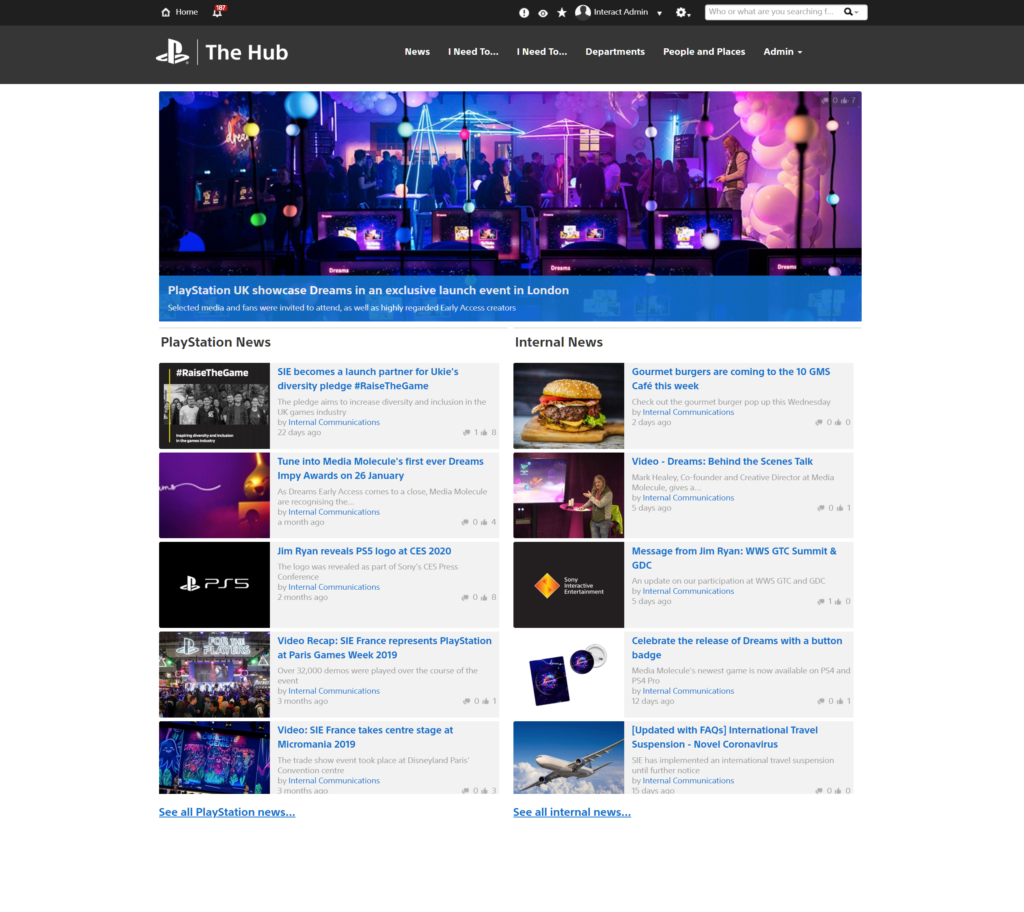
The Hub combines need-to-know business information with both external and internal news, and a content area dedicated to ‘People and Places’. Employees can see overviews of the different parts of the organization and what their colleagues do, read about successes and share photos, events, and updates. The Hub serves to connect every employee to their organization and each other.
Just one month after launch, an internal survey revealed:
- 72% of staff agree The Hub keeps them informed about what’s happening in the organization, an increase of +25%
- The number of employees who agree The Hub accurately reflects PlayStation as an organization shot up by +45%
These stats and PlayStation’s approach show how are great ways to get the staff excited and keep them enthusiastic about their work, therefore at peak performance.
6 – Ensuring transparent internal communications
We saw with International Rescue Committee how they make use of internal communications tools to build transparency at their organization – allowing employees to gain visibility of senior management through their intranet software.
Your Housing Group (YHG) brings us another approach to the same concept by working with internal stakeholders and champions. More organizations are making use of senior stakeholder comms on their intranet as a way of connecting upper-level employees with the rest of the company. This is an example of collaboration on a high level, ensuring that all workers understand the leadership’s vision for the organization.
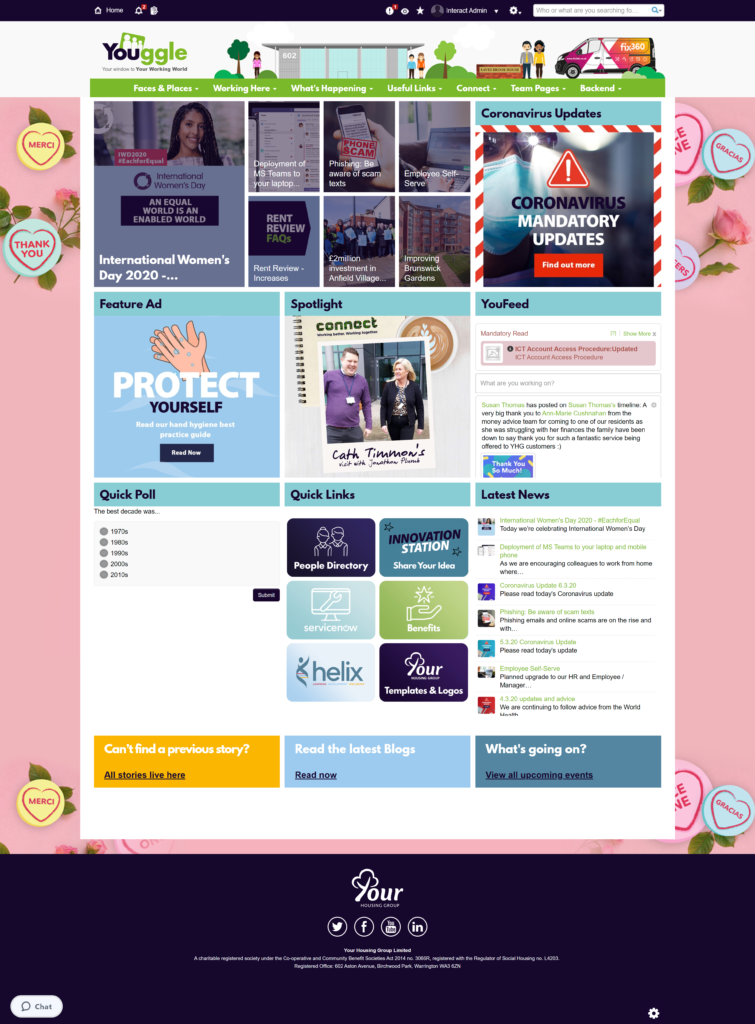
YHG’s People Plus Director, Stephen Joyce, serves as one of the organization’s top influencers: focused on bringing engaging comms to the Group’s employee base, primarily through video.
His example empowers other senior leaders to follow suit, with the whole team now regularly delivering updates and engaging with staff: improving visibility and transparency.
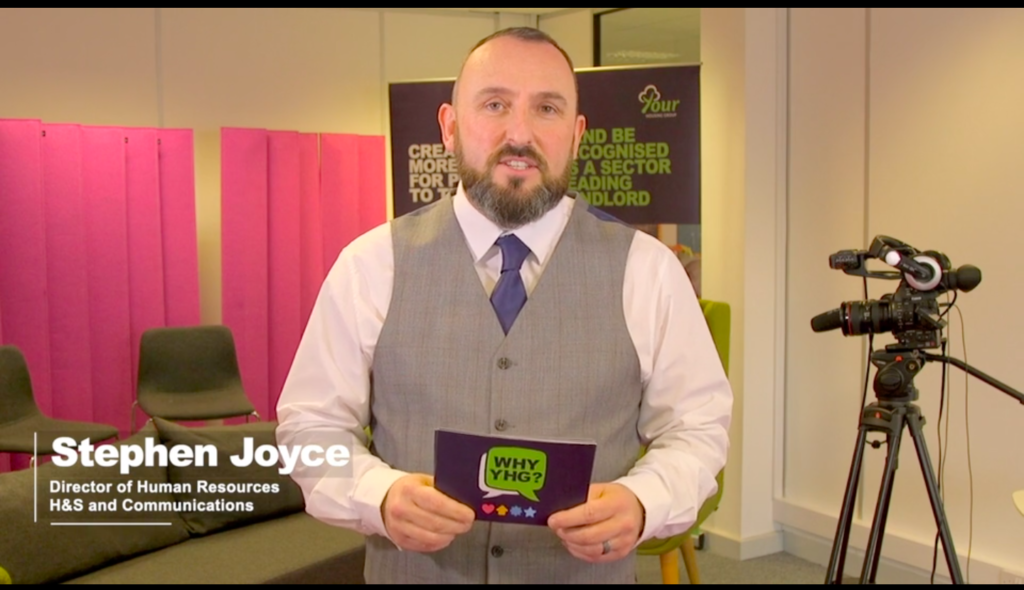
This type of collaboration is purposeful as it serves to keep the organization working toward a set of goals they all understand. Top-down communication may not work for every purpose, but it is very effective in communicating vision and establishing uniform guidelines.
7 – Intranet use cases can include financial ROI
When executed properly, collaboration positively affects all areas of a business and delivers tangible business returns by connecting people and information.
The UK’s largest integrated property services group, Countrywide, has harnessed the potential of its intranet Our Place to great benefit. Before a revamp of the intranet, staff struggled as the group continued to grow and staff operated in siloes. Internal Communications Manager Kelly McGall reflects:
“We could only imagine a world where colleagues from Finance could celebrate alongside our Estate Agency teams… or our mortgage consultants congratulating someone from HR.”
The Internal Communications and Engagement Team overhauled their intranet software with a focus on recognition and breaking employees out of their departmental siloes. Their approach saw Countrywide secure a Ragan award for employee recognition.
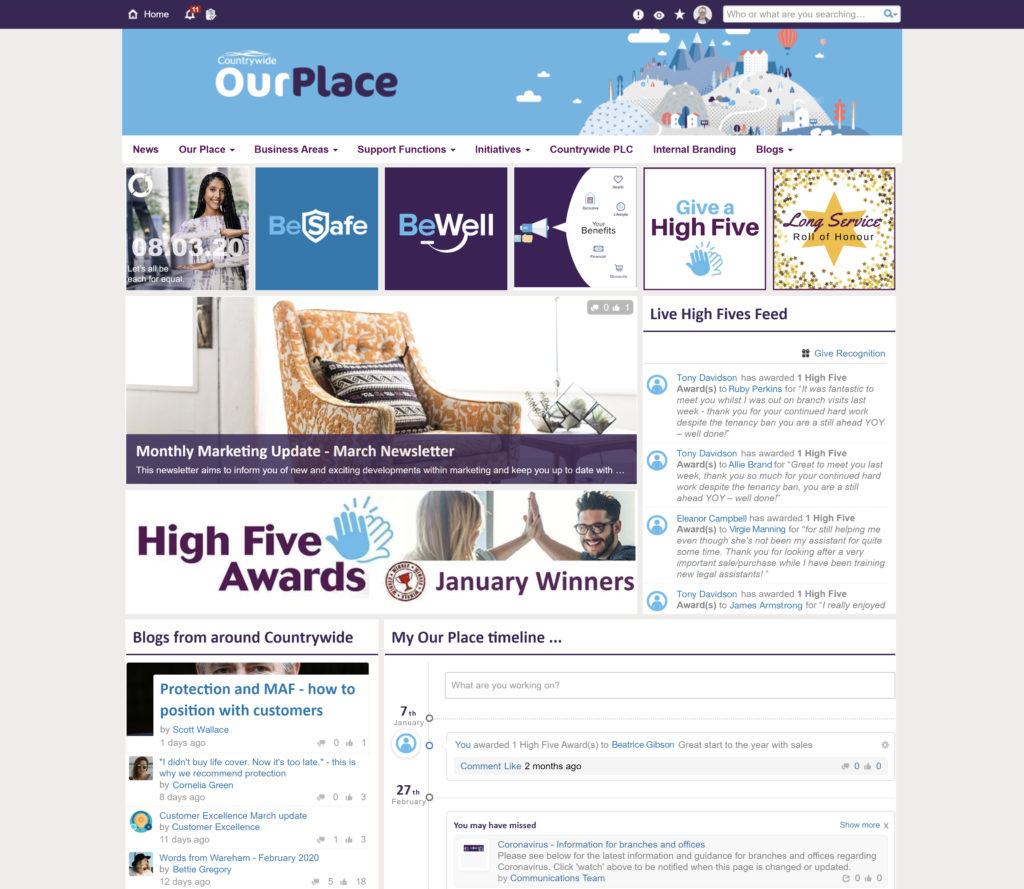
By improving visibility and connection to colleagues, Countrywide has drastically improved internal collaboration. The business impact is tangible:
- 500% increase in usage of Our Place
- Performance on cross-selling – income from complementary services – increased from 43p in the £ in 2018, to 49p in the £ in 2019 as staff worked better together
- Income from conveyancing grew 27% YoY
- Empowering staff to self-serve on their intranet saw a 66% reduction in HR queries
- An internal recruitment referrals program managed on Our Place has saved the group an estimated £600,000
Internal communication tools, when executed strategically, do more than simply improve communication: the benefits can be felt throughout organizations.
8 – Create a single version of the truth for internal content
With email and other traditional methods of passing documents back and forth in an organization, there is the danger that multiple people will all be working from different versions of a document.
Inconsistency in working materials means inconsistency in results, and the negative consequences can range from fairly minuscule to significant. It could mean missing customer deadlines or failing to read important open enrollment announcements.
Imagine, for example, that two workers in a financial firm are working with two different sets of regulations and that because one is outdated, that worker breaks a law and costs the firm a large sum of money in fines. To combat this, one intranet use case is to consolidate your Document Management Systems or to use a CMS intranet to natively create and publish important content.
Is your intranet mission critical?
9 – Use your intranet to recognize staff contributions
One of the key drivers of employee engagement is ensuring that stress doesn’t lower team morale. With morale lowered, workers are less productive and less likely to work to their full potential. Not only that, but low morale significantly raises the probability of employee turnover. So what is to be done to mitigate the risks of low morale, even during periods of stress?
One of the simplest solutions is employee recognition. When workers know that they are valued and that their hard work has paid off for themselves and others, this can contribute significantly to keeping their spirits raised and keeping them engaged. Luckily, there are internal communications tools that easily allow workers to recognize one another’s efforts. TaxAudit.com used the Rewards feature on their intranet to its fullest potential.
As Estes explains, “We’ve found that Interact Rewards is a hugely successful way to increase employee engagement. We’ve seen a ton of spontaneous altruism, with employees giving colleagues ‘WOW Points’ for volunteering for projects or going beyond the call of duty. We also did our bit, investing around $40,000 dollars in prizes to make the initiative work. We now have more than 80% daily engagement on the intranet and counting.”
10 – Ensure employee participation
How does an internal communicator or a manager ensure that their messages to employees are actually being read – and that staff are participating and engaging in response?
After all, the effort that goes into carefully crafting any internal communication is for naught if no one pays attention. This is essential to purposeful collaboration; all parties need to be on board in order to work well together.
Global fitness brand Equinox has a dispersed workforce, the majority of which won’t typically been sat at a computer but instead, out in the field or on the gym floor. Tapping into that dynamic and encouraging staff to contribute presents a unique challenge.
It’s one Equinox has risen to. Its intranet, EQX Connect, is beautifully designed with a mobile-first ethos to ensure every individual can connect from anywhere, on any device, on the go. By centering its content strategy on the use of video, they’ve also created an accessible, digestible medium that staff can use to gain valuable updates and information in limited snippets of time.
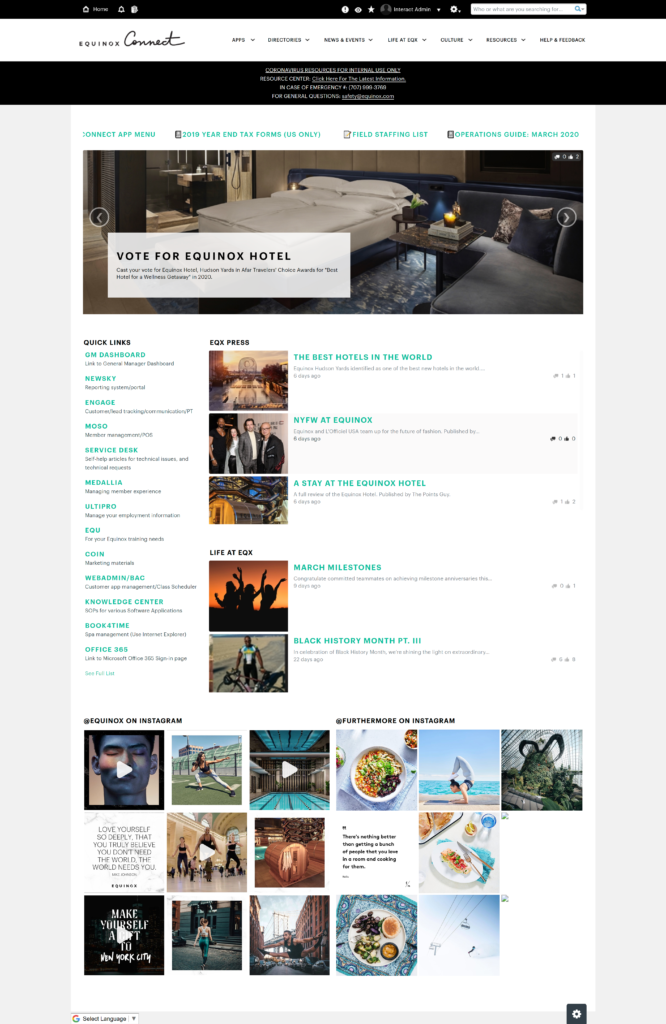
However, it was by listening to what its staff wanted that the team were really able to take participation up to the next level. After feedback and analytics showed a gap, ‘Life at EQX’ was launched as a content area on the intranet. From employee spotlights to celebrating promotions and birthdays, introducing new hires, or sharing fun facts and stories from staff: it’s the virtual cultural hub of the organization, inspiring staff to get involved and participate.
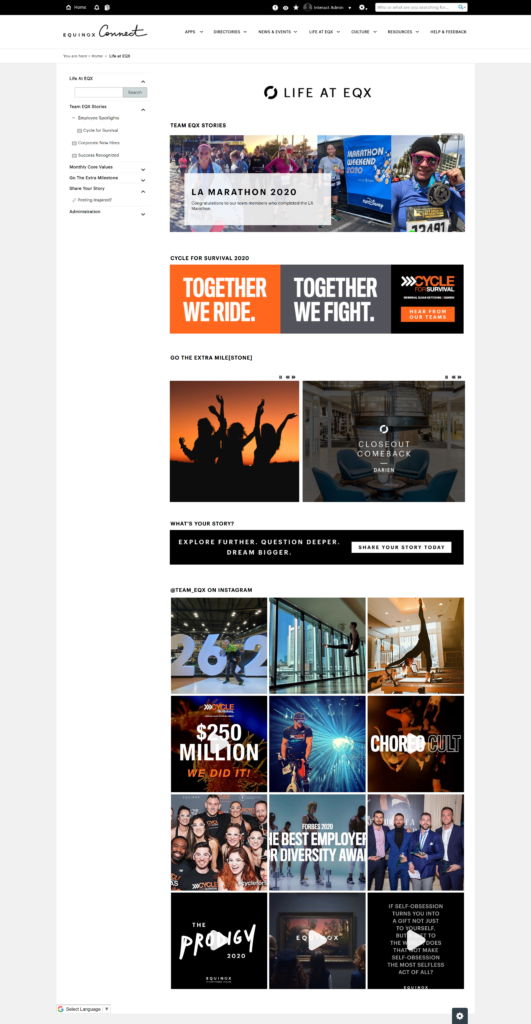
Since its launch, Life at EQX has earned the leading number of likes over any other area of the intranet, topping over 33,000 visits in its first year with unique visitors increasing by 65%.
There are many more intranet use cases
As with any piece of transformational software, there are hundreds of ways you can use your intranet to improve comms and productivity. Take a look at examples in our free intranet resources to learn more about how you can create a better connected workplace with Interact.
